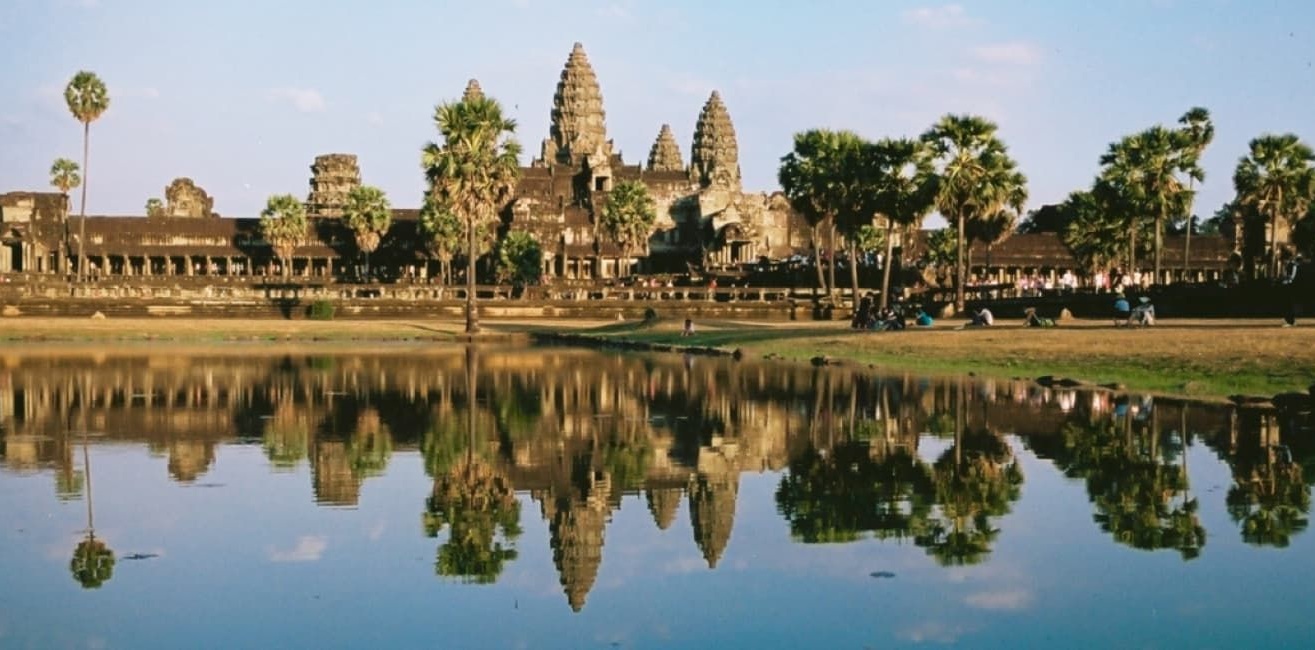Cambodia: History of Angkor Wat Temple
The history of the mysterious Angkor Wat temple complex in Cambodia

The mighty archeological park of Angkor in Cambodia bursts all size dimensions. Built by a powerful ruling dynasty, it contains several old royal cities and thousands of temples.
The most famous of them is Angkor Wat, the largest sacred building in the world.
In the dense jungle of northern Cambodia, not far from the city of Siem Reap, lies an impressive monument from a bygone era: the so-called Angkor Archaeological Park, a collection of old royal cities and temples at the same time. The most important and most frequently visited place by tourists in the more than 400 square kilometer complex is the mighty Angkor Wat temple. It is a building of absolute superlatives and covers an area four times the size of Vatican City. This makes it the largest sacred building in the world.
According to “Geo”, Angkor was already the capital of the powerful Khmer dynasty at the beginning of the 12th century and had more than a million inhabitants. The city’s wealth is based on an ingenious irrigation system that allows up to four rice harvests per year. The Khmer have ruled large parts of what is now Cambodia, Vietnam, Laos, Thailand and Myanmar since the 9th century. And so Angkor becomes not only the political but also the religious center of a gigantic empire. And at the heart of it are countless temples. But one of them is supposed to put them all in the shade: the sacred building Angkor Wat.
It was common among the Khmer of that time for each ruler of a Hindu deity to have at least one temple built. This is also what King Suryavarman II thinks when he commissions Angkor Wat. He wants to erect an unprecedented monument to Vishnu, one of the main Hindu gods. The temple should therefore be an image of the entire Hindu universe on earth. Thousands of slaves and countless stonemasons, goldsmiths and other artists dedicated themselves to the construction of the monument in the following decades. The result is the largest religious complex of all time.
Decayed in large parts
For the construction, an area measuring 1500 by 1300 meters will be excavated and millions of cubic meters of earth will be moved. Then workers built the mega-complex that is now known around the world as Angkor Wat from more than a million precisely cut blocks of sandstone. Working elephants and buffalo bring them to the “construction site” from a distance of 30 kilometers. Dedicated to the Hindu god Vishnu, the temple’s five towers are said to symbolize the five peaks of the mythical Mount Meru. According to Hindu belief, this is where the gods live. The wide moat that encloses the complex with its almost five meter high walls symbolizes the ocean, which is said to have surrounded the Meru.
At its highest point, the temple of Angkor Wat rises more than 60 meters into the air – an almost magical dimension for the time. Thousands of reliefs depicting Hindu deities adorn the buildings. One of the pictures also shows the king’s entry into his new capital. After a total of almost 40 years, Angkor Wat, the heart of the capital and now the most powerful sacred building in the world, is finished. The monument covers an area of two square kilometers, surrounded by a 200 meter wide moat.
Looted, abandoned, forgotten
Hard to believe, but by the end of the 12th century Angkor was already losing its importance as the center of the Khmer empire. Because in 1177, according to the “Encyclopedia Britannica”, warriors from today’s Vietnam conquer and plunder the city. The new king, Jayavarman VII, then feels betrayed by his Hindu gods and decides to build a new capital with Angkor Thom. This is dedicated to a new faith, namely Buddhism. Many of the stone images in the mega-monument, which had previously shown Hindu scenes, are now being replaced accordingly. Suryavarman’s temple then becomes a Buddhist monastery. And gets its current name Angkor Wat, which translates as “the city that is a temple”.
Angkor Wat is still a sacred place for Buddhists today. It is believed that the god Indra created him in just one night. Then, in the 15th century, the once glamorous capital it is in is finally abandoned, according to the BBC. The Khmer kings moved further south, where they built today’s capital, Phnom Penh. However, Angkor Wat remained an important center of the Buddhist faith until the 18th century, despite progressive decline. Eventually, however, the rampant jungle incorporated the system. It wasn’t until the 1860s that it was finally rediscovered – and that’s thanks to a sort of real Indiana Jones.
The rediscovery of a legend
In 1858, the young Frenchman Henri Mohout sailed from London to Southeast Asia, which he traveled like an adventurer for several years, according to the BBC. He also visits Angkor Wat. In his diary, published posthumously in 1863, he raves about the legendary temple: “It is grander than anything that the Greeks and Romans left us.” In that year, a French colonial government also took power over what is now Cambodia. Then, in the early 20th century, they begin to rebuild the entire complex of Angkor for tourism. However, it was not until the 1960s that serious steps were taken towards a restoration.
However, these were abruptly interrupted when civil war broke out in the still young nation of Cambodia in 1970. The bullet holes in the walls of Angkor Wat, which can still be seen today, also date from this period. In 1992, Unesco declared a 400 square kilometer area, on which both Angkor Wat and Angkor Thom are located, to be a World Heritage Site. Today it is known as Angkor Archaeological Park. According to the Phnom Penh Post newspaper, more than two and a half million visitors came in 2019. And the latest figures also indicate that tourism here is recovering very quickly after the corona pandemic.
According to Cambodia’s official tourism website, anyone wishing to visit the World Heritage complex must purchase an Angkor Pass in advance. This is available in three different versions. The day ticket currently costs 37 dollars (just under 35 euros). The three-day pass is available for $62 (a good €58), the seven-day pass for $72 (almost €68). With this you can not only visit Angkor Wat, but also other monuments in the area. Angkor Wat is open daily from 05:00 to 17:30 as many visitors like to watch the sunrise here.

